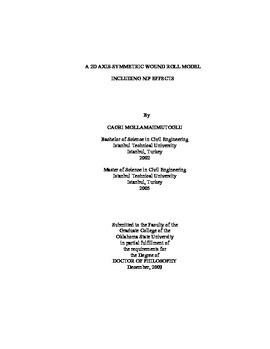| dc.contributor.advisor | Good, J. Keith | |
| dc.contributor.author | Mollamahmutoglu, Cagri | |
| dc.date.accessioned | 2013-12-10T18:05:20Z | |
| dc.date.available | 2013-12-10T18:05:20Z | |
| dc.date.issued | 2009-12 | |
| dc.identifier.uri | https://hdl.handle.net/11244/7810 | |
| dc.description.abstract | Scope and Method of Study: A 2D axis-symmetric wound roll model including nip effects which is based on a pre-stress finite element analysis has been developed. The combined model consists of three interactive sub-models. In the first sub-model the notion of pre-stress has been utilized to incorporate web line tension as a source of load. The pre-stress formulation allows easy allocation of web line tension in case of CMD thickness nonuniformities. In the second sub-model a roll compression algorithm has been developed via 2D plane finite elements. The roll compression model was used to characterize radial stiffness of the wound roll in the third sub model at various CMD positions. The third sub-model represents the roll and nip contact as a 2D beam spring contact and solves for the nip induced pressures along the CMD. Finally these nip induced pressures were used in the first sub-model in the wound-on tension calculation. This cyclic process between sub-models continues till simulation ends. The model is compared with existing literature and the tests completed at the WHRC of OSU. A segmented instrumented core is constructed and the core pressures were obtained for a polyester web of known thickness variation. | |
| dc.description.abstract | Finding and Conclusions: The Pre-stress formulation was shown to be adequate even for highly compressible materials by comparing with Benson's and Good's model, and Good's experiment. Validity of the pre-stress formulation in 2D wound roll modeling is shown by comparing with Hakiel's model and experiment. It is found that even for high nip wrap angles the roll profile still dominates tension allocation. Roll contact analysis showed that radii of contacting cylinders are important in stiffness calculations. It is shown that thickness data sparsity is important for the modeling of highly irregular and radical webs. Finally it is concluded that the combined model can be used to predict maximum pressure levels and pressure patterns correctly even for poor thickness data. | |
| dc.format | application/pdf | |
| dc.language | en_US | |
| dc.rights | Copyright is held by the author who has granted the Oklahoma State University Library the non-exclusive right to share this material in its institutional repository. Contact Digital Library Services at lib-dls@okstate.edu or 405-744-9161 for the permission policy on the use, reproduction or distribution of this material. | |
| dc.title | 2D axis-symmetric wound roll model including nip effects | |
| dc.contributor.committeeMember | Singh, Raman P. | |
| dc.contributor.committeeMember | Yin, Wei | |
| dc.contributor.committeeMember | Bulut, Rifat | |
| osu.filename | Mollamahmutoglu_okstate_0664D_10701.pdf | |
| osu.accesstype | Open Access | |
| dc.type.genre | Dissertation | |
| dc.type.material | Text | |
| dc.subject.keywords | 2d wound roll model | |
| dc.subject.keywords | axis-symmetric finite elements | |
| dc.subject.keywords | large deformations | |
| dc.subject.keywords | nip induced tension | |
| dc.subject.keywords | pre-stress formulat | |
| thesis.degree.discipline | Mechanical Engineering | |
| thesis.degree.grantor | Oklahoma State University | |
